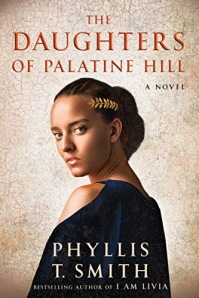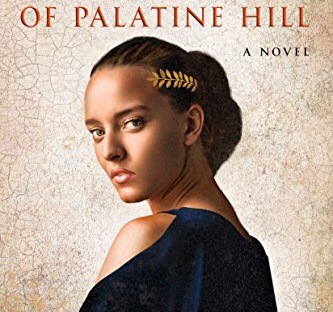If you’re looking for a read about how a republic and its senate submitted grudgingly but totally to a tyrannical leader who promised to repair all problems by pushing nationalist ideals and harsh foreign policy, you should be reading about Ancient Rome.
Phyllis T. Smith’s The Daughters of Palatine Hill (2016) spans about 30-40 years of the reign of Caesar Augustus, from the point of view of his wife, Livia Drusilla, his daughter,  Julia, and his foster child/captive, Cleopatra Selene. For some historical background (which is by no means required to enjoy the book), Caesar Augustus came into full power in 27 BC after years vying for political power in the Republic. His early years as First Citizen of Rome were dominated by political upheaval, as he was a strict leader and was less than democratic in his policies, though he was open to free speech and opinion, as long as it never took action. Livia Drusilla was his second wife, whom he had an affair with while they were both married to other people. They divorced their spouses and by all accounts had a passionate and strong marriage, as she took on more political responsibilities than most women of her culture. Julia was Augustus’ only biological child, born of his first marriage, and raised by him and Livia. She was a political pawn, beloved by the people but marred three separate times to men her father wanted to favor. Cleopatra Selene was the daughter of the legendary Mark Antony and Cleopatra, captured by the Romans after her parents had lost the war and had committed suicide. She was raised by her parents’ enemies and lived her life as a loyal Roman. From the viewpoints of these three intriguing women, Smith weaves a story that questions the strength of loyalty and familial ties.
Julia, and his foster child/captive, Cleopatra Selene. For some historical background (which is by no means required to enjoy the book), Caesar Augustus came into full power in 27 BC after years vying for political power in the Republic. His early years as First Citizen of Rome were dominated by political upheaval, as he was a strict leader and was less than democratic in his policies, though he was open to free speech and opinion, as long as it never took action. Livia Drusilla was his second wife, whom he had an affair with while they were both married to other people. They divorced their spouses and by all accounts had a passionate and strong marriage, as she took on more political responsibilities than most women of her culture. Julia was Augustus’ only biological child, born of his first marriage, and raised by him and Livia. She was a political pawn, beloved by the people but marred three separate times to men her father wanted to favor. Cleopatra Selene was the daughter of the legendary Mark Antony and Cleopatra, captured by the Romans after her parents had lost the war and had committed suicide. She was raised by her parents’ enemies and lived her life as a loyal Roman. From the viewpoints of these three intriguing women, Smith weaves a story that questions the strength of loyalty and familial ties.
Smith’s knowledge of history does not prevent her from giving each character a human characterization and elements readers can empathize with. Many historians have painted Augustus’ wife Livia as a heartless and manipulative monster, and some historical fiction has followed suit. She was a powerful woman who had sway over the greatest man of that age and like him, she had to make rational decisions regardless of personal feeling. Smith portrays Livia as a woman who struggles with the decisions she has to make, especially as she sympathizes with the citizens grumbling for a return of a free republic. But she is unshakingly loyal to Augustus out of both love and admiration, even as she disagrees with and attempts to persuade him in certain cases. She has two sons, Tiberius and Drusus, who she has trouble relating to but fervently loves, and she takes on the responsibility of all of Augustus’ young relatives, ever concerned about how the people see their family. Augustus’ daughter Julia is most remembered historically as promiscuous, indulging in multiple affairs and orgies. In Smith’s novel, like many 20th-21st century depictions (Robert Graves’ I, Claudius for one), Julia is shown as a sympathetic good-hearted character. She is a wild child at heart, yearning to break free from her royal responsibilities and also longing for her father to love her enough to care about her happiness. A romantic, she keeps on hoping for a great love like the kind she reads about in Catullus, but is constantly disappointed in the men she marries, all of whom see her as a tool to get closer to her father. Cleopatra Selene is a quiet and thoughtful girl, constantly afraid that the Romans will see her as a threat because of her birth. She stifles her thoughts of vengeance and submits to Augustus’ household, though she cannot forget that he sought to kill her parents and had her brothers executed. Driven by her mother’s command to live, Selene avoids friendship and hope until she meets Juba, a young captive prince of North Africa who Augustus has taken under his wing. The three women’s stories of love, fear, pain, hope, motherhood, and boldness in a harsh male-dominated world span over decades and are even more fascinating when you remember how much truth there is in the events.
At times when an author, especially a historical novelist, aims for breadth in a novel, they sacrifice some depth, unless they are willing to write a 900-page book (looking at you, Sharon Kay Penman). Smith’s novel is 412 pages, which is not long for a book that spans  over 30 years, telling the lives of three main characters. A lot is skimmed over, and it is Selene’s story, which I was most interested in (her historical trajectory from Egyptian princess to Roman captive to African queen is almost too strange to be true), that got abridged. Her early years in Rome are detailed, but after she gets married her chapters are short and rare. Julia gets the most page-time, which is fair as she had a life of constant upheaval (widowed twice, divorced once). Personally, I felt that much of Livia’s storyline could have been cut. Smith told of Livia’s early life in her previous book, I Am Livia, so I understand her desire to tell Livia’s side of these later events, but the character of Livia undergoes very little growth in The Daughters of Palatine Hill. She is something of what Steven James, author of Story Trumps Structure, calls a “pebble character”. She is not very much affected or changed by the events of the story, even the death of one of her beloved children (a character saying they’ve changed is not the same as them displaying change in behavior or attitude). This is not bad characterization necessarily, but it affects how compelling a character is. Livia’s perspective, particularly her relationship with Augustus, is interesting, but overall was not the most memorable aspect of the novel. The novel would have benefited from expansion or reduction–as it was, the attention given to the POV characters felt lopsided.
over 30 years, telling the lives of three main characters. A lot is skimmed over, and it is Selene’s story, which I was most interested in (her historical trajectory from Egyptian princess to Roman captive to African queen is almost too strange to be true), that got abridged. Her early years in Rome are detailed, but after she gets married her chapters are short and rare. Julia gets the most page-time, which is fair as she had a life of constant upheaval (widowed twice, divorced once). Personally, I felt that much of Livia’s storyline could have been cut. Smith told of Livia’s early life in her previous book, I Am Livia, so I understand her desire to tell Livia’s side of these later events, but the character of Livia undergoes very little growth in The Daughters of Palatine Hill. She is something of what Steven James, author of Story Trumps Structure, calls a “pebble character”. She is not very much affected or changed by the events of the story, even the death of one of her beloved children (a character saying they’ve changed is not the same as them displaying change in behavior or attitude). This is not bad characterization necessarily, but it affects how compelling a character is. Livia’s perspective, particularly her relationship with Augustus, is interesting, but overall was not the most memorable aspect of the novel. The novel would have benefited from expansion or reduction–as it was, the attention given to the POV characters felt lopsided.
I would give the novel 3.5/5 stars. It’s well-researched and intriguing, with a lot of drama that can be fun for both the historian and the non-historian. Yet much of the interest rises from Smith’s source material itself–the historical lives of her subjects. She does not add much of a drastic spin on the truth, and when she almost does–like her love-hungry Tiberius–she doesn’t take it as far as she could. I truly enjoyed the novel and am interested to read more of Smith’s work. Like a good historical fiction, it also got me wanting to brush up on my non-fiction historical reading, so I might be checking out a book on Tiberius or Livia soon (if I can remember to pay my library fees…thank God for Kindle!). Recommending this especially for you those of you who aren’t history nerds. Read this and then you have my permission to tackle Graves’ phenomenal (but very dense) Claudius series.
Brittany Ann Zayas
